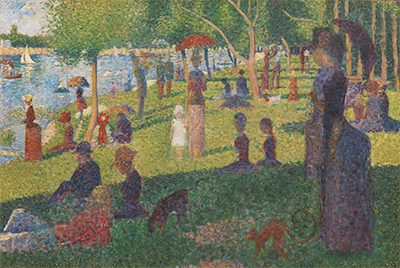This was a preliminary work for the more famous, and much larger, A Sunday Afternoon on the Island of La Grande Jatte. Seurat spent a great deal of time studying the Parisians at leisure on La Grande Jatte island in the River Seine.
He made numerous drawings and paintings while attempting to perfect his depiction of the figures as they enjoyed themselves by the river.
A Sunday on La Grande Jatte - a five year undertaking
The final product of the process of this painting project became Seurat's most famous work. His work in creating 'studies' for the final painting began in 1884 when the artist was still using the traditional oil paints which contained 'dull earth' pigments. As the project evolved, Seurat became interested in more complex colour uses as put forward by a number of scientists at that time.
He started to paint using a series of dots which became known as 'pointillism' and were employed in his later works. It is considered that there are now only three 'studies' for the final painting now still in existence. The advanced techniques employed by Georges Seurat led to him being considered as the father of 'Neo-Impressionism'. The artist worked tirelessly on perfecting both the landscape of the park and in developing his technique for representing humans in the artwork.
It should be noted that when painting landscapes, particularly those of the French coastal towns, he would not include any human figures in his work.
Description
The artwork displays a typical Sunday afternoon on the island of La Grande Jatte where the Parisians would enjoy their .day off'. The lower 40 percent of the canvas depicts the subjects cast within a shadow while those who are further away are bathed in the bright sunlight. The scene is typical of the time with adults walking hand-in-hand with their children, couples standing face-to-face and groups of people sitting on the grass.
The painting displays the geometrical style preferred by Seurat. The line of the near river bank running parallel to the opposite bank until it finally starts to merge in the distance. Many of the trees have upright trunks topped by 'fluffy' leaves which resemble a kind of 'green candyfloss'. As previously noted, many of the artist's later landscape works do not feature humans or animals in them. Georges Seurat's work evolved over time and this painting shows how he moved from using traditional painting techniques to develop his pioneering pointillism.




